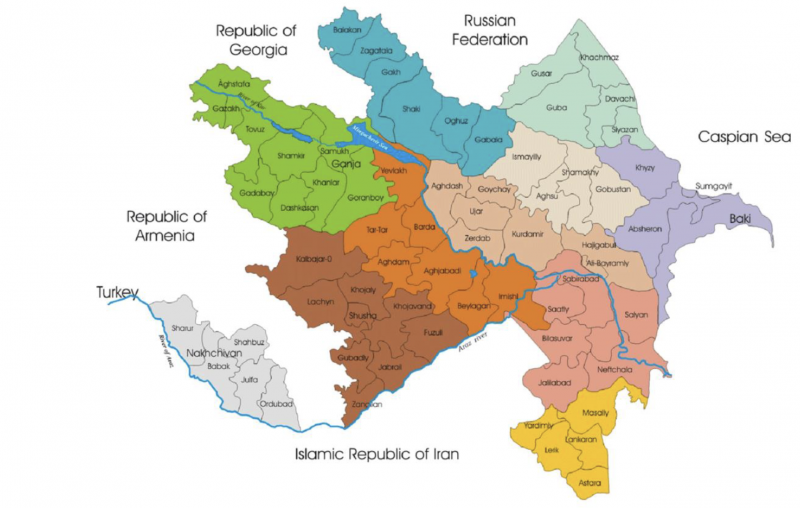Flood Protection, Modernization and Expansion of the Irrigated Areas Project in the Nakhchivan Autonomous Republic.
Introduction
In the Nakhchivan Autonomous Republic, agriculture is an important part of the economy and employs the largest part of the labour (70%) compared to industry and services sectors. Most rural people are engaged in both crop and livestock production. Nakhchivan has a potential to expand irrigated agricultural land for about 150,000 ha, out of which 60,000 ha are cultivated.
Agriculture sector growth will boost the economy, and will ensure food security of Nakhchivan. The main crops cultivated are wheat, potato, vegetables, fruit, and sugar beet. 100% of agricultural production isused for local consumption but satisfies only 90% of Nakhchivan population needs. Azerbaijan has numerous and extensive natural floodplains associated with the Astara, Samur, and Kura – Araz river basins. Large areas of agriculture,
various villages and main towns, and essential infrastructure are affected by flooding on the wide lower Kura River and Araz River floodplains, particularly near to and downstream of Sabirabad. The frequency of dangerous or damaging floods varies, and some mountain streams experience flash floods once every two years on average, and torrents every 5 to 10 years. Many lives have been lost in flash floods and torrents especially where the settlements are close to the mountains.
This Project is addressing both challenges by modernizing and expanding irrigated agriculture and building protection structures from frequent flooding as well as improving farmers’ access to efficient irrigation scheme. The project was approved by the bank on 01/05/2011, financing agreement was signed on 26/11/2011 and declared effective on 01/01/2012.

(Image: Map of the Project Locations)
Objective
The overall objective of the project was to enhance food security, poverty reduction and improve the management of water resources and land protection. The development objective was to increase agricultural production and incomes of smallholders, protect land against erosion and protect irrigated areas and villages against floods.
The project’s development objectives and expected outputs were aligned with the key strategic thrusts of the IsDB’s vision 1440 H to reduce poverty, boost prosperity, and enhance the economy. It addressed several objectives of Azerbaijan’s the State Program on Secure Food Supply to the Population in the Republic of Azerbaijan (SPSFSP), which underline the significant role of agriculture in national food security, income generation, and employment potential.
The project after its completion remains aligned and contributes to the IsDB 10 years Strategy as Pillar - 1 Economic and Social Infrastructure. It also contributes to the Sustainable Development Goal (SDG) adopted in 2015 and specifically the SDG No.2: Achieve food security and promote sustainable agriculture, SDG No.6: Water for all and SDG No.13: Climate change.
Positive Impact
The occurrence of floods and associated damages have been reduced. The welfare of the people in the Araz River improved as a result of a reduction in floods which also used to cause water - borne diseases having a negative impact on health. From an economic perspective, a total of 6,800 ha of land is currently irrigated. The project contributes significantly to the agricultural development through improved irrigation scheme, increased agriculturalproductivity and production in the Nakhchivan Autonomous Republic.
An increase of the production of wheat (wheat: 3 - 5 tons/ha and barley: 3 - 5 tons/ha), fruits, vegetables and sugarcane resulted from improved irrigation scheme. Also, the project developed newly irrigated areas in 3,800 ha, thus improved the welfare of the local communities and contributed to the food security in Azerbaijan. The project indicatively resulted in an increase of the average productivity of the main crops by about 22% and the crop production by 100,000 ton/year. The cereal import at a national level reduced by 3.6% and farmers’ income increased by 8%.
- 31.5 km of flood protection structures along Araz River completed.
-
308 km of irrigation, and drainage systems modernised (representing 230 drainages) in Vaykhir Left Bank Irrigation Scheme.
-
5,400 m3/h capacity of Shir Pumping station, with 6.0 km of pressured pipeline and 105.5 km of irrigation canals constructed in Sadarak.
-
3,600 m3/h capacity of the Pumpingstation, with 32,4 km of gravity pipelines.
-
9 km of pressured pipeline and 135.3 km of irrigation canals constructed in Kangarli.